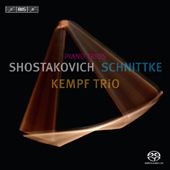
ESSENTIAL RECORDINGS

Desolation, suffering, bone-chilling cold, darkness, pain and death. All of these images and emotions are imbedded within every single note of the opening pages of the Piano Trio No. 2 in E minor, Op. 67 by Dmitri Shostakovich, and only a great composer like Shostakovich would submit all this weltschmerz to a fugal treatment and still make it work. The Kempf Trio comprised of Freddy Kempf on piano, Pierre Bensaid on violin, and Alexander Chaushian on cello, expose every emotional fibre of this music like no other group ever has. Notice the chill in the steely cold strings against the sombre, pain laden piano notes. Playing of that caliber really brings home the fact that this work was written in 1944 against the backdrop of war. After the 3:00 minute mark, the music picks up the pace as if determined to change its fate but never seems to achieve that state, and the movement ends in resignation. In the much livelier second movement, the trio members play like a well-oiled machine. In particular, all those short and sharp crescendos (which produce a kind of mwow effect) scattered throughout this short scherzo are clear and articulate as the players react instinctively to each other. Solemn piano chords, like the beginning of a Beethoven piano sonata, open the following slow movement and set the tone of this dramatic segment in which the exchange of the main motif between instruments emphasizes its sad nature. The music that opens the finale sounds like the backdrop score to a puppet show, stiff and clumsy, but eventually leads to a whirlwind of Jewish sounding folk songs and dances, a gesture much influenced by the music of Shostakovich's friend, Mieczyslaw Weinberg. After reaching a peak of tremendous activity and fantastic playing by the trio members, the music slowly dissolves and re-visits the previous themes. The work ends in typical Shostakovich manner, in an enigmatic whisper.
The Piano Trio No. 1 in C minor, Op. 8, was written when Shostakovich was a teenager, a few months after his father had died and he himself had been diagnosed with tuberculosis. It is written in one movement, and is much more concerned with form and structure than with emotional discourse. Its balanced use of all three instruments is exemplary and its neo-classical form belies its roots. Take for example the ever so typical 19th century ending. This work makes for a perfect buffer between the two emotional giants that bookend this CD.
If two Shostakovich piano trios were not enough, this recording also includes the 1992 Piano Trio by Alfred Schnittke, an arrangement by himself of his String Trio from 1985. It's a perfect match to the Shostakovich No. 2. It is a stark, bleak and moving two movement work that presents musical ideas that will linger on your mind. I for one, for some unknown reason, seem to hear quotations of the Star-Spangled Banner in the opening movement. Again the Kempf Trio project the emotional tone of the piece very well, and capture the enigmatic nature of the ending perfectly.
The CD booklet notes state that this recording was done in 2004. Why it was only released now in January 2010 is beyond me. It might have to do with the fact that the Kempf Trio, which was formed back in 2000 has apparently recently disbanded. Better late than never I suppose, especially for an interpretation and recording this good.
Jean-Yves Duperron